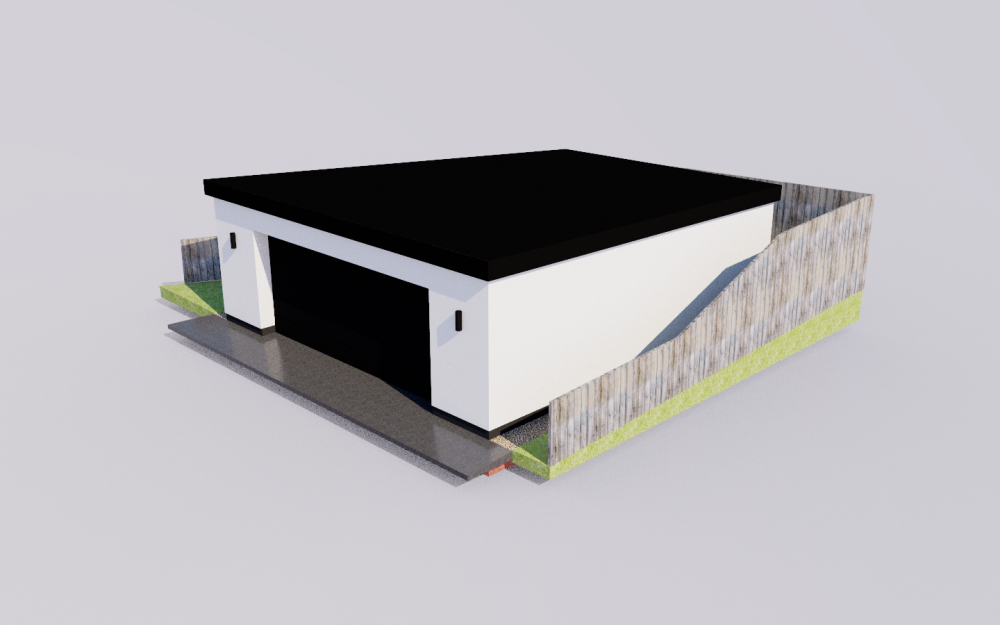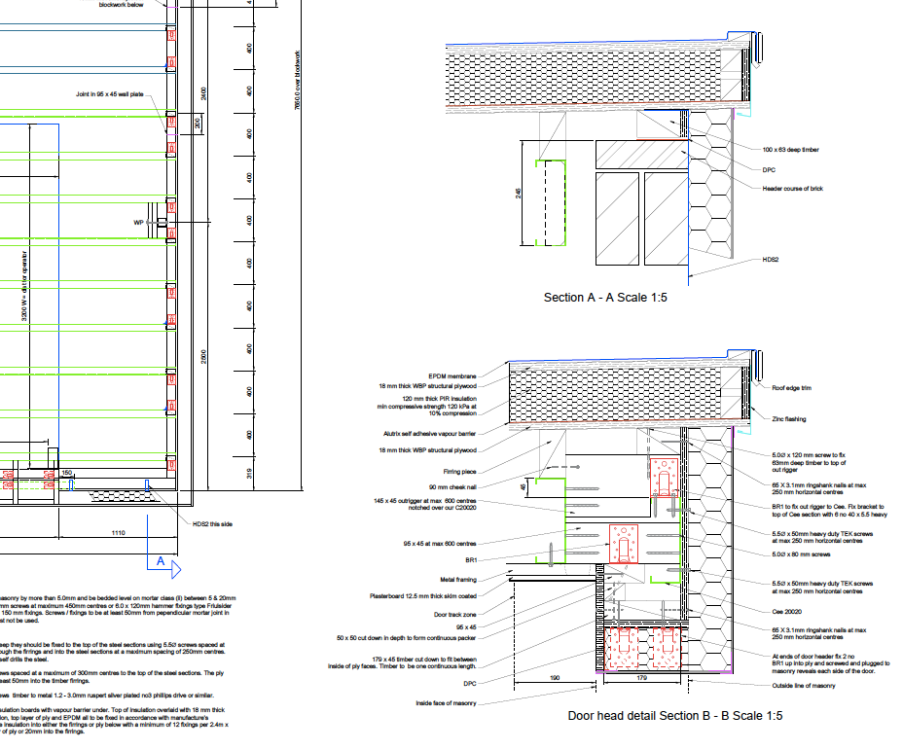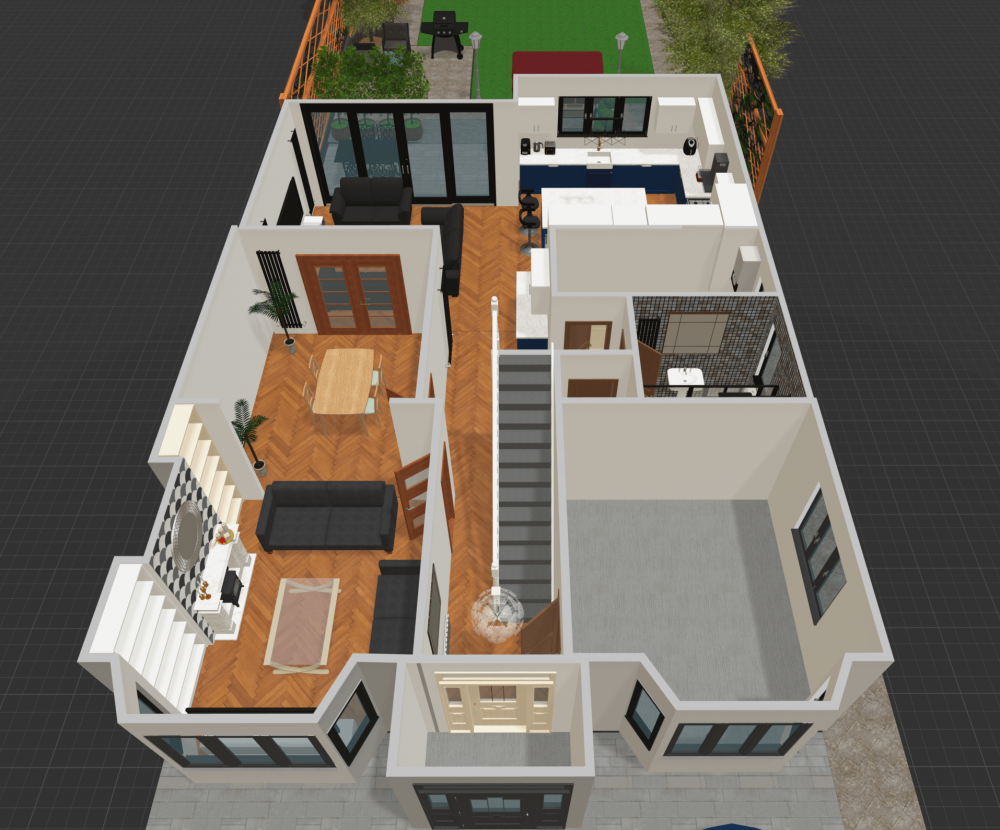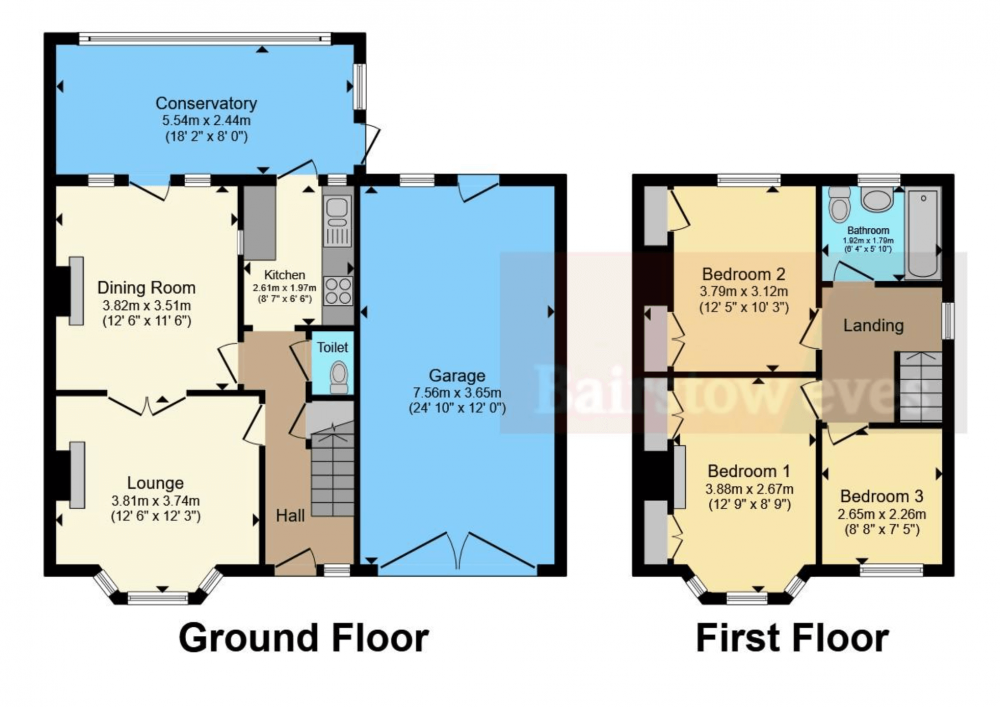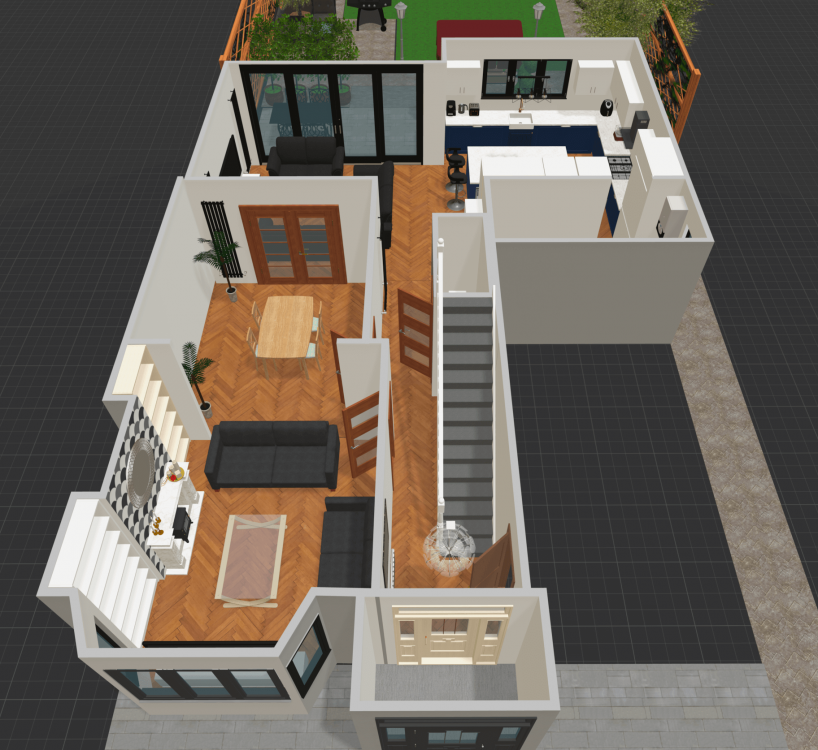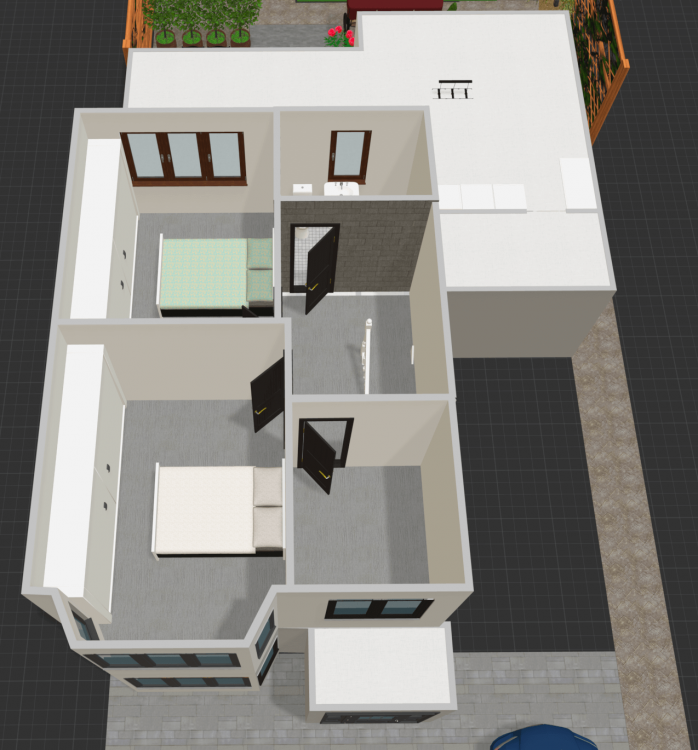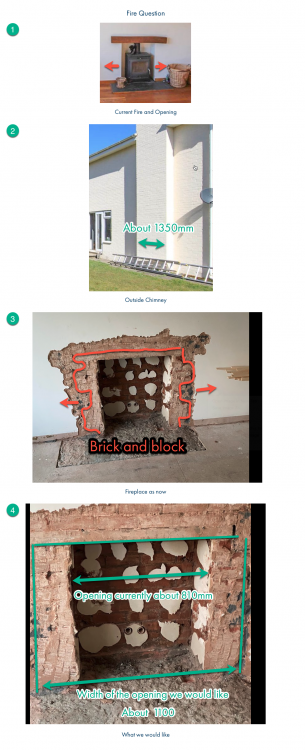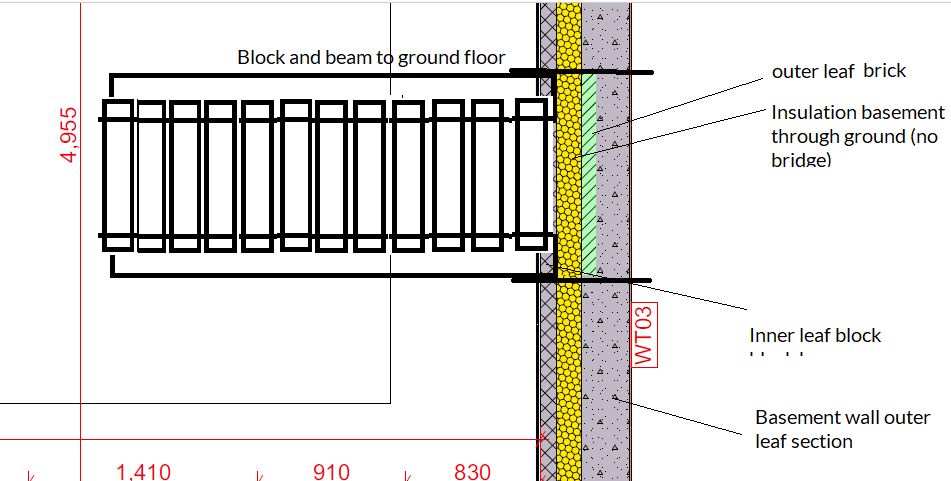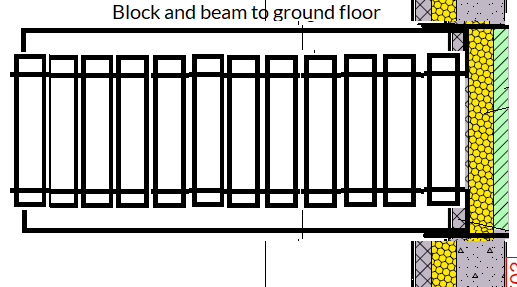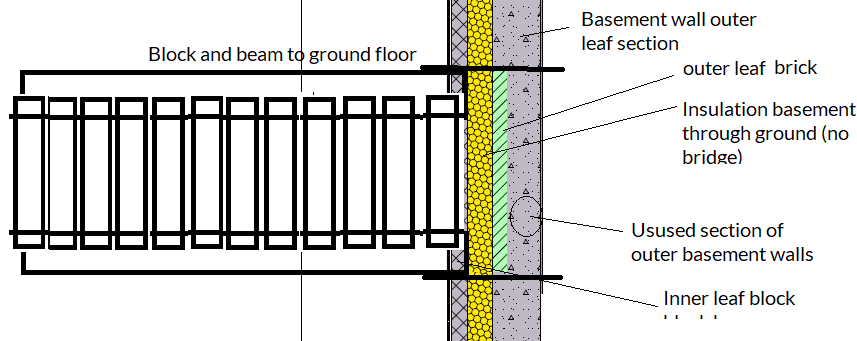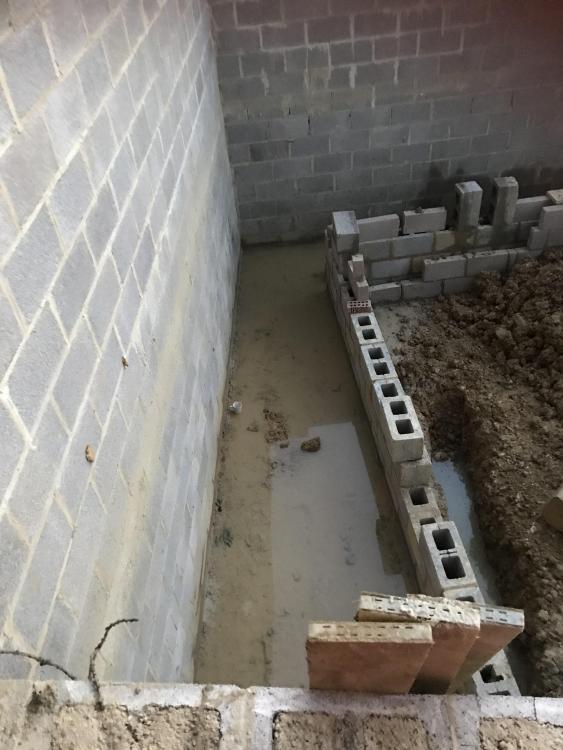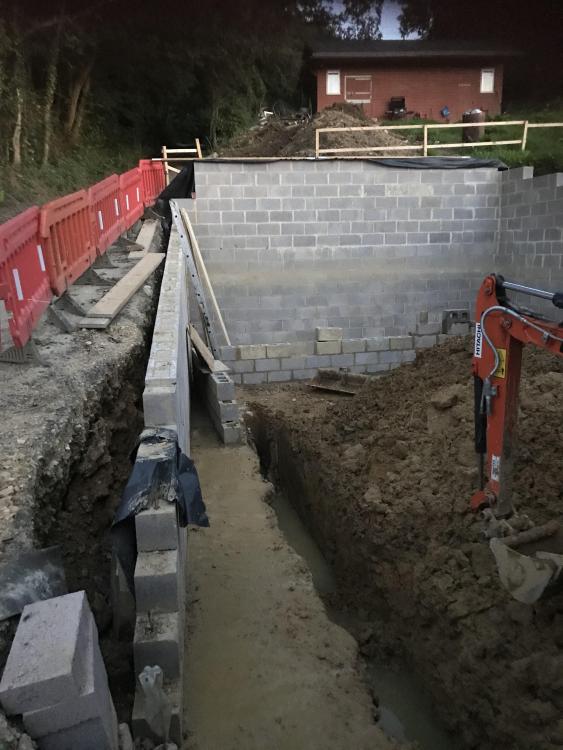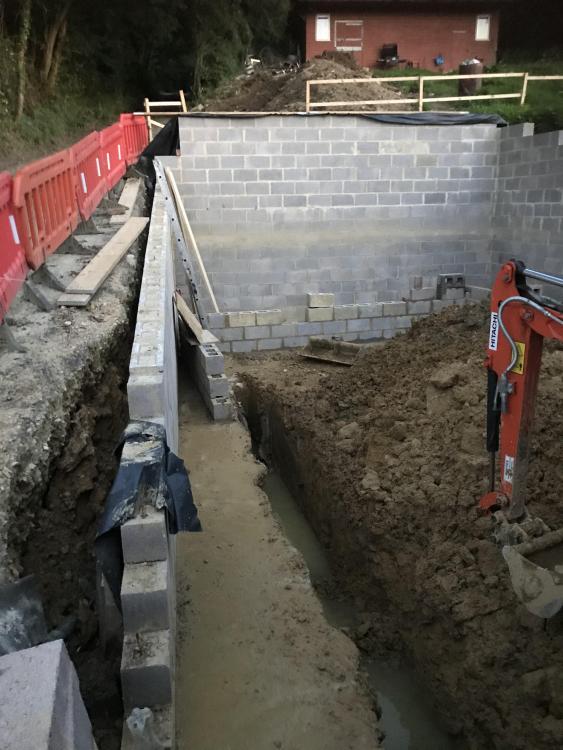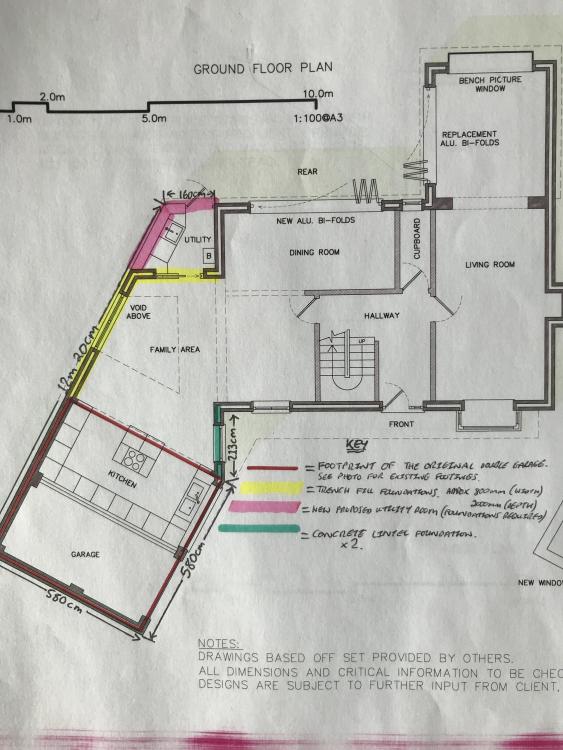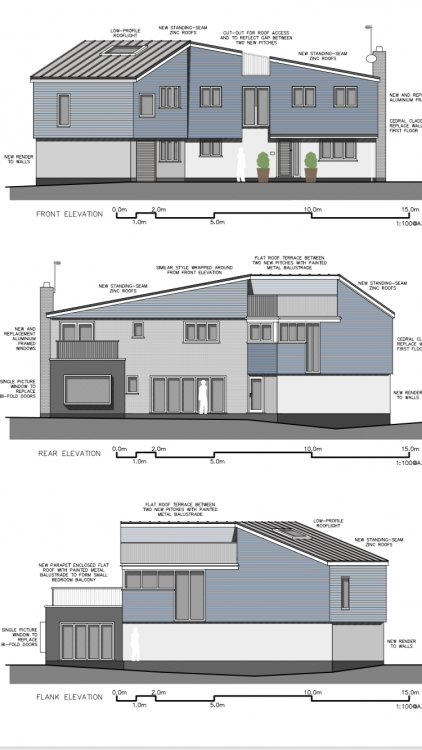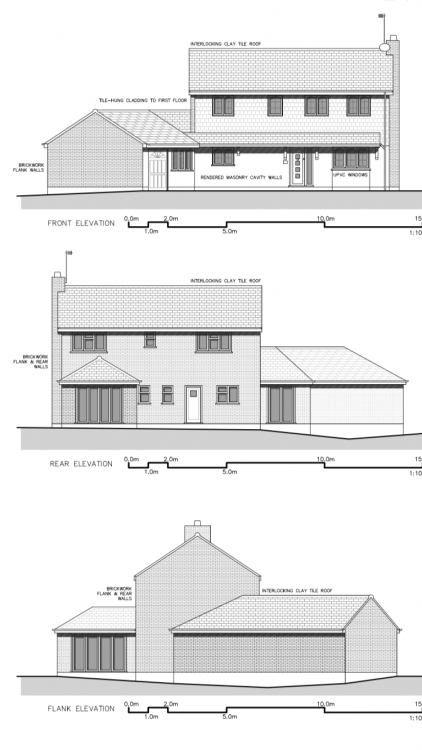Search the Community
Showing results for tags 'structural engineer'.
-
Designing my new build detached garage in SketchUp was easy. Finding someone to convert my fantasy garage into something that Building Control would be happy with was more difficult. I wanted the detached garage to be well insulated, and I may well have got a bit carried away. I wanted to use Geocell Foamglass for the foundation topped off with a concrete slab. I then wanted single skin blockwork clad with external insulation that married up with the Foamglass so that the slab and block work where inside the thermal envelope. I also wanted a warm flat roof. On top of this the garage was to be trapezoidal in plan to make the most of our odd shaped plot and big enough at the front to take a 5m garage door and finally I wanted a thermal break at the door between the slab and the outside world I contacted a local Structural Engineer who came round for a site visit. There more I spoke the more bewildered he looked. He'd never heard of Foamglass, not necessarily an issue but he didn't seem even vaguely interested in finding out more about it and its utilisation. I rapidly came to the conclusion that I couldn't work with him so I pondered my next move and decided to get in touch with a (well known on here) Structural Engineer/Architectural Designer who happens to live at the other end of the country. I wondered if he'd be able to help me out or steer me in the right direction. It turned out that he could. More than that, he took on board all the odd things I wanted to do and worked with me brilliantly. He's an absolute mine of information and had lots of great input with which to finesse my design and he clearly knew what he was talking about which is so reassuring. A site visit wasn't necessary, I provided a site survey and soil survey from the house build and then photos and Google Earth filled in any blanks. I probably drove him nuts, every drawing he sent I added to my SketchUp design because I really wanted (needed) to understand how it was going to go together and didn't want the standard "the builder will know what to do". There was a great deal of detail in the drawings: The upshot of this long story is that working with a Structural Engineer/House Designer who I'd never met and who never visited the site was a great experience and I'm glad I looked further afield than the local offerings and would recommend the same approach to anyone else looking for an SE/Architectural Designer. You’ll find him here:@Gus Potter and if you’re looking for a Structural Engineer/Architectural Designer I would heartily recommend you get in touch 👍🏻
- 27 replies
-
- 4
-

-

-
- detached garage
- structural engineer
-
(and 1 more)
Tagged with:
-
Hello all, apologies if a similar question has been raised in the forum. I did search extensively beforehand. For my house extension, we have decided to add a basement. The original plans that the structural engineer created, stated that the outside walls of the basement were to be made using blockwork. The structural engineer made site visits in advance of the original plan. This plan was used for tendering and the basement company we choice, estimated according to the original SE plan. During further discussions between the SE and the basement company, the outside walls are now to be made of reinforced concrete. This redesign has increased the costs of the basement significantly. Nobody informed me of the increase in costs that this change would cause until shortly before the basement works started, leaving me with no option but to proceed with the basement. I am now in dispute with the structural engineer over this matter. I have a few questions: 1. Am I right to point the finger at the SE? 2. What are my options? 3. Would I be within my rights to withhold any due invoices towards the SE until this matter is clarified? Thank you all in advance!
-
My dad is removing a chimney breast which is load bearing from an end of terrace Victorian property in Cardiff. He needs a structural engineer. How would you go about finding a someone reliable, but not too expensive? All the ones that are coming up on his google searches are big companies who don't really do small residential jobs.
-
Hi, I am seriously considering "outsourcing" my structural calculations and technical design drawings via UPWORK and wondering if anybody done anything like this before. As I was planning to manage the build myself I already been looking on UPWORK for an architect, but at the end wasnt brave enough to employ someone to do this from far away without knowledge of the plot. Now that I have got my Plannijg drawings together and only need someone to translate them into Technical Design Drawings - I am considering again to use a structural Engneer/Architct from Serbia/Ukraine/Pakistan/Bangladesh to do the technical drawings for me. I do know exactly what I want and have all the Technical drawings including Sections ready in an amateur style / homemade, but missing the AutoCad skills to make it into useable drawings plus I dont really fancy reading myself into structural calculation and woul rather leave this to someone with experience. Please also tell me if you seriously concidered doing something like this and why you have/havent . I can see a problem when it comes to UK Building regs(some bits are different here then in other countries, e.g. no Lightswitches/plugs in the bathroom) - but this would be something to be sorted by myself to make sure the plans comply.
-
Hi there, this is my first post. I'm seeking some advice on how I go about planning my home extension. I am buying a 3 bed semi which is need of a complete gut out. We would like to do a double side + rear extension. I have an initial budget of approx £110k +£20k contingency to spend now in order to get the house ready to move in. I had a builder suggest phasing the refurb+build as the £130k probably wouldn't get us the whole double side + rear extension we're looking to do. I'm speaking to an architect about it to give us some options, but I'd love to get some advice and second opinions from experts on the forum that have done projects like this before. My main questions are How would you phase the build, given the initial budget will only stretch so far and we want to move in ASAP? Structurally, what do we need to consider with each phase if we took this approach? Roughly, do our budgets sound about right? Current floor plan Proposed phase 1 ground and first floor Refurb inside (new electrics, plastering, plumbing, boiler, floor, heating, doors, windows) Knock down existing garage and leave empty (building foundations for future phase) Rear extension approx 45m/sq (kitchen/diner + utility space) Proposed phase 2 Double side extension Build over existing rear extension for part double rear Loft - not part of design
-
Hello we have just bought a house, and we would like to open our fireplace to have more space around the log burner, I took out the fire this weekend and hacked off some of the plaster around with a SDS drill, we want to open up by about 6 inches each side, but im concerned it will be to wide for the chimney breast. Please see the picture below and if somebody can advise what I should do that would be amazing. My concern is that if I hit the bricks down on each side this will go through the chimney breast, or at least the first skin.
- 27 replies
-
- fire
- structural engineer
-
(and 2 more)
Tagged with:
-
We’re building a two storey extension with SIPs. We have a final architectural design, which includes a floating first floor and a sedum roof. We are in urgent need of a structural engineer who can design the structure, leveraging the SIPs structural capabilities and including any supporting steelwork needed. The property is in Cambridge. We commissioned a structural engineer before deciding on SIPs and while they said it wouldn’t make a difference, we’ve really struggled to get them to produce a design and now they say they need someone else to design the frames and they won’t take professional liability for the structure if we go with SIPs. Any recommendations of a structural engineer experienced in working specifically with SIPs would be much appreciated.
-
My Architectural Engineer and Structural Engineer have both only supplied PDF drawings, and have stated they will not provide editable (.DWG) files that I can use to extract measurements from in order advise suppliers. The former claims it would invalidate his insurance. Should I be relying on the figure in the PDF's? Am I making an unusual request? Has anyone else been able to get such files from their professions? Is my eye for detail not suited to the building trade and should I be relying on measurements taken on the ground (which I can understand when it comes to ordering things that go in holes like windows and doors, but they're not on (or in ) the ground ? )?
- 9 replies
-
- structural engineer
- architectural engineer
-
(and 2 more)
Tagged with:
-
Hey, would really appreciate your views on this one! Looking for thoughts on structural support for block and beam on a new build with basement and the various preferences from my designers Basement: 300mm concrete walls, internal cavity with insulation, inner leaf block, plasterboard Ground floor upwards: outer leaf brickwork, cavity with insulation, inner leaf blockwork My Architect wants an unbroken insulation zone from the basement to the roof, and to make this happen the block and beam to ground floor will sit on the inner leaf blockwork built up from the basement 300mm slab. We will also have block and beam on the 1st floor, so again the block and beam will sit to the inner leaf blockwork. Architect's request: My SE instead wants to shift over the block and beam so that the inner section of the 300mm basement walls provide structural support for the floors, rather than the blockwork as shown above. This is going to introduce a bridge to the insulation layer. The SE said if we use the above approach he wants to install steel posts and beams to support the floors above. SE Preference: If we didnt have a basement, and still planned to use block and beam, the beams for the floor would sit on the inner leaf of the block wall anyway. Just because we place a basement wall in does not mean it then has to be used to support the beam/hollow core floor? When we get to the 1st floor we have another block and beam, and for this we have no option but to sit the beams on the inner leaf block work. Which option should we go with? Thank you
- 28 replies
-
- basement
- structural engineer
-
(and 2 more)
Tagged with:
-
Hello, we’re building an extension, the retaining walls are up and now the builders are laying down the brickwork for the house. The problem is that it is starting to look like two rectangles, one inside the other at completely different angles. I have attached some photos for a slightly better picture.
- 4 replies
-
- structural engineer
- retaining wall
-
(and 1 more)
Tagged with:
-
We are attempting a loft conversion which, speaking freely, has divided opinion among both tradespeople and structural engineers. Some have said: "you're going to need multiple cranked steels up there" (pushing the cost up to prohibitive levels), others have said "it's already stood for 100 years with a 350kg water tank up there forcing down, it'll be fine by doubling up all the joists, strengthening this, securing that etc". Ultimately we've found a structural engineer who'll design it without floor steels but with flitch beams. His ltd company has been in business since 2012. Likewise, we have a well known building regs company willing to sign off on said drawings. Finally, obviously, we have our own buildings insurance. With some of the sceptics' words ringing in my ears, I want to take this to the worst case scenario: we convert this loft, gradually it pushes out the eaves or something, causing damage to load bearing walls and, generally, The House. Can anyone explain what happens next? We see mahoosive cracks appearing in the walls or something bowing dramatically and then we.... - call the structural engineer and his insurance covers the repairs cost? - call the building regs guy and his insurance covers it? - call our own insurance, show them the hard evidence that we engaged professionals BEFORE undertaking these works, and they then cover it? What are the pitfalls? Where are the booby traps? I mean, I badly want this loft space (it's going to be an amazing f/t study), but I'm not completely stupid, I don't want to wreck my house doing it... Any thoughts most welcome.
- 7 replies
-
- structural engineer
- building regs
-
(and 1 more)
Tagged with:
-
Sorry in advance for the length of this. In August 2017, I commissioned a local firm of structural engineers to take some plans which had passed planning and created plans which would pass building regs. They actually quoted for structural diagrams, building regs and sap calcs. They wanted me to use their preferred building control contractor but at £2,200 inc VAT I thought that was a bit much and decided to use the local authority service for around £800, which the builder was more than happy with. Since then they have delayed and delayed. It took from August until early November before the plans were submitted. The plans failed over Christmas, as the building inspector was still waiting for over 36 different items of information. By April the inspector passed the plans conditionally but made it clear that he was still waiting for more info. I didn't push this as the SE had explained that a lot of the info would become clear as the build progressed and would be provided as and when. This generally seemed reasonable. Fast forward to the current time and the builder (different one this time - first one had to drop out as Polish workforce went home and did not come back) has started on the groundworks and was chasing some information from the BR submission only to find it was missing - confirmed by the inspector. I suggested we get a meeting together with the SE, but when I mentioned this to the SE, he wouldn't go for it unless he could charge. I've had a frustrating day trying to explain to the SE that the builder is only asking for data that should have been in the BR submission and that the inspector has confirmed this. SE seems to think that the builder should know all of the data he's asking for and says it costs him time/money to explain things when the builder should just 'get it'. I have explained to the SE that the inspector does not consider the BR complete and the builder is within his rights to ask for it. To try to resolve the impasse, I suggested that SE does not deal with builder but completes all outstanding work ASAP to the satisfaction of the inspector. If after that the builder still needs to speak to him, then I'm happy to pay if necessary. No response yet, but I'm not hopefully after waiting so long. Has anyone had a similar situation? The SE has already taken over a year to do this and the last request was sent to them eight months ago. I am tempted to write to them telling them that I will have to seek help elsewhere and claw back the overspend through the small claims court, though like most self builders, I've not really the time or money to be doing that.
-
Foundation design for Durisol - help!!!
MattButt posted a topic in Insulated Concrete Formwork (ICF)
Hi all, A bit about our project - we have planning permission for a large-ish double storey side extension for our house in Hertfordshire. There is a single storey infill extension (block and brick) that I built in 2014, attached to and converted one of two detached double garages that were already there. I’m at the stage now where I’m researching different build types for the extension and am really drawn to the ICF and SIPs style of build, particularly Durisol. The problem I’m having is finding a structural engineer that isn’t going to charge me an absolutely fortune (£8000 the first quote!!) for an existing foundation review and design of a raft foundation so if anyone can recommend a good structural engineer with experience of ICF in particular I’d be eternally grateful!! I really get the impression that the professional services see that you’re a self-builder and add a zero onto their quote!! I’ve attached the existing and proposed elevations and the ground plan that shows the existing foundation make up. The existing flooring on the plan that shows the Family Area is block and beam, the kitchen and garage are a concrete slab on strip foundations and the utility area is proposed ie. hasn’t been built yet!!Any advice would be really appreciated!! -
I've just received my completion certificate for the extension that was built here (praise be!!!) but it hasn't been without its challenges as we didn't 'follow the rules'. I will note the issues I had below just to provide some hopefully useful info to others about the mess you can get in if you don't follow process. We didn't set out to deliberately ignore process but it ended up being the case. The background was that we purchased the plot (in Scotland) complete with planning permission and building warrant for this house. The PP and building warrant covered 2 houses one of which was already built and sold, and the builder sold us the 2nd plot complete with foundations. Once we bought it my husband wanted to change the house style slightly which included adding an extra single storey room at the back of the house, but the planners told him that they wouldn't allow it even though it would be allowed under permitted development once the house was built. So we made some changes to the internal layout only and the building warrant covering both houses was swapped into my husband's name. The timber frame company was asked to design the house to make it easy to add the extension at a later date so for example French doors were put in that could be moved to the new external access later, and a double door sized insulated 'panel' was put in that allowed a new internal door to be added easily later as it just required blocks to be removed and the panel removed. When the groundworks were being done my husband got the foundations for the new room laid and these were used as a 'patio' initially. The plan was that the main house would be signed off and then we would apply for a warrant for the extension. When my husband got sick he decided that he would get the extension built no matter what despite the main build not being signed off, and no attempt at reasoning with him would change his mind. He told me to apply for the warrant retrospectively later on but I’m sure he didn’t envisage that this would cause me as many issues as it turned out. So builders came out and added the single storey room at the back of the house . The only part of the build that he had no input to. His intention was that the racing simulator would be housed in it but that's still sitting in the garage ....... After he died and I finally got my head around completing the outstanding elements of the main build to allow the completion certificate to be issued I admitted to the council that there was an extra room here. I was told to submit a new warrant application which I did but it was then refused (although they still took the 500 quid) as there was already a warrant in place that wasn't satisfied and there couldn't be 2 warrants running. The council decided to make it an amendment to the existing warrant and although both this house and next door had SER certificates and form Qs issued for the main builds I was asked to obtain a new SER certificate from scratch for my house to factor in the new room. I tried to engage the original structural engineer who had provided the SER certificate and Form Q but he had left the scheme / industry and couldn't be located. I was then advised by a local SE to engage the SE who had been engaged by the timber frame company as at least they wouldn't be starting from scratch. However the SE said that the SER scheme didn't allow them to do what the council was asking. I've included some of the emails below as they tell the story better than I could articulate it. Here is the email the council sent me stating that the SE certificate was only required for my own house: It is worth pointing out that you only require a new SER certificate for your house including the extension and not the neighbouring plot. The neighbouring plot will be dealt with separately. The SE said that this was not possible and asked the council to 'turn a blind eye to the extension' in order to allow the main house to be signed off. The council said that they were unable to do this so here is the email the SE sent to the SER scheme. We have been approached by a Client wishing us to take over the SER from another SER Engineer. The original SER Engineer is no longer on the system seems to have left the engineering trade. Normally we would seek confirmation from the original SER Engineer that they were happy for us to take over the responsibility for their SER before we accept the appointment. In this case this is not possible. The matter is further complicated by the following facts; . There are 2 houses on the site covered by the same warrant reference. House 1 is built and awaiting a completion certificate. This cannot be provided until the form Q for the full SER has been provided to building control. The Form Q needs to be signed by the original SER Engineer. House 2 carried out additional works and applied for a warrant during construction. Their warrant application needs an amended SER to cover the additional works. . The amended SER needs to be an amendment of the original SER if it is all covered under the original Warrant. . The changes to the house include the introduction of a sunroom to the rear of the property. . Our understanding is that if we took on the SER we would; Need to take responsibility for both houses as there should only be one SER per warrant application; We would need carry out site investigations to determine how to design the foundations as there is no available information. This will mean carrying out investigations in House 1 which is complete and house 2; And we would need to carry out a full review of the designs for both houses amending the SER to suit the changes. Both houses have different kit suppliers and different calculations to be reviewed. It has been suggested by the Council that a new SER could be carried out for House 2 only. We believe this would be contrary to the SER system but any advice on this would be appreciated. We are happy to take on the project but we need to be in line with your recommendations. And the SER scheme's reply: We have considered your query and you are correct in saying that to provide a certificate which covers the design of house 2 only would be contrary to the requirements of the scheme as they are currently written. The Scheme Guide says in 4.6.15: 4.6.15 In exceptional circumstances this may not be possible (e.g. if for any reason the Certifier of the initial stages of the work is no longer available). In this eventuality the Certifier of the later works must not sign the relevant design certificate(s) unless and until they have satisfied themselves of the adequacy of all of the preceding stages of the work and the mutual compatibility of the various stages of the works. We realise that this requirement is particularly onerous in situations such as you have described and we are in dialogue with Building Standards Division to see if they would accept a revised form of wording. Until we hear back from BSD we are unable to offer any further advice. I do apologise for the delay in response to this query. The council repeatedly told me that the only needed an SER for my house and not next door, but also that the SER scheme was 'not very flexible'. My neighbours were also less than impressed that the SE wanted to dig up their foundations as their garden has all been landscaped etc. and they've lived there since 2008. And the costs mentioned to prepare 2 SER certificates for 2 large houses from scratch weren’t insignificant either. Weeks passed with no news from the SER scheme (I doubt these things ever resolve quickly), and the council threatened to cancel the warrant if things didn't resolve soon. I was left caught in the middle of a paperwork nightmare with seemingly no way of influencing the outcome. If I had found BH while this was going on I might have at least felt supported but it was just me caught in the middle of a nightmare at the time. Then suddenly out of the blue the council phoned me and said that they would treat the extension as a separate warrant (which is what the SE asked them to do from the get go). Here is their email to me. Further to our telephone conversation we have reviewed the file and feel that we can justify that the original warrant openings into where the extension is built was covered by the original engineer and therefore can issue completion on xx/xx/xxxxxx once the snagging items including the 2nd drain are completed. This leaves the extension which has been applied for as an amendment xx/xxxxx/xxx can be changed to a new warrant application (ALTEXT) For which we require a SER certificate to cover the extension only. I spoke to XXX who says that this should be able to be done by the end of the year for which we extend the application deadline too. The other issue is that the warrant XX/XXXXX/XXXXX is due to expire at the end of the month, unless the drain test can be arranged before then, we will require a further extension of £100 fee. So suddenly I had a way forward and by some miracle was able to get a plumber out to carry out the second drain test (the only thing still outstanding) within the 7 day deadline and the main house was finally signed off. Then the SER certificate for the extension was finally issued (but the SE company forgot to sign it hence the comment in the email below) and the council came and carried out the completion inspection and only required some minor things to be done as per the email below. Further to the inspection this morning I note the following: 1. The roof construction differs from the submitted drawings as it has traditional sarking boards and a breather membrane in lieu of OSB and roof ventilators. 2. The windows are not fitted with trickle vents – I appreciate the rest of the house has a whole house ventilation system, however there is no evidence this is connected to the sun room, therefore trickle vents will need to be fitted retrospectively. 3. There is an additional step to the patio door landing. 4. The signed SER is required. If you confirm by email that you are happy for me to amend the drawings to take account of items 1 and 3 I will do this for you and if we receive the signed SER certificate that will enable us to approve and issue the building warrant. Upon receipt of this you will need to apply for the completion certificate and I will need to check the trickle vents have been installed. So they even offered to make the changes on the drawings for me which was great. I think they just wanted to see the back of me in truth! . So all a bit of a saga and a warning not to step outside of process too much, or at least understand the possible consequences of doing so! I can imagine my hubby looking down saying it was 'character building'!
- 10 replies
-
- 2
-

-
- building warrant
- building control
- (and 5 more)
-
Chance meetings, research and no fear of being nosy have stood me in good stead for many years and it's proving no different with getting a house built. The 'dig deep' thing was bothering me, mainly the thought of having to go down 2m over the entire footprint of the build and the cost of all that muckaway, as well as the risk of it all turning into a giant, muddy swimming pool during the process. I will freely admit that up until about 10 days ago, the thought of having to get piling included in the build struck terror into me due to what I perceived as the potential cost and complexity involved, all down to my own ignorance about piling. As a new comer to the world of self building, the only thing I'd really picked up on in the past was hearing about remedial work to houses that were falling down and the huge amounts of cash involved. I'd already had a mooch around this site to see what I could see on the matter of piles and had a look at @recoveringacademic's blog and his comments and rapidly lost my fear but not my trepidation over costs. I also had a visit to the build site of another BH member who has been very helpful and encouraging. It was a spontaneous visit as I was really, truly just passing by his site on the way to my own, but his structural engineer was there at the time so I stood quietly by and ear-wigged, as you do, and then one thing led to another and we started chatting about my site and my clay dilemma. The upshot is that the SEs were really helpful guys and I'm engaging them to design a piling system to support my MBC build and overcome the risk of both lateral and vertical movement that my site is very vulnerable to. I'm also having them design the drainage system while they're at it. They will liaise with the architect, building control and the timber frame company and make sure that my build not only gets out of the ground but stays in the same place once it's done. I've never had an issue with professional fees as long as they are ones that are genuine and add value to a project. In this case, it will be money very well spent and a huge weight off my mind. How best to approach the drainage plan had been vexing me for the last few weeks, particularly as my clay soil means that soakaways don't function. One thing that I think may be worth mentioning is the combination of the passive slab and a piling system. The soil beneath the building is not just highly shrinkable clay, but also very dessicated thanks to the long term presence of a few trees and a super thirsty hawthorn hedge. Although these are all now gone, their long term potential affect on the soil will remain for a long time. In particular, the risk of heave. The piling system will keep the building in place, but does nothing to stop the swelling of the clay directly underneath from pushing up and breaking the floor of the new structure. The SE started to talk about a suspended floor to mitigate against this. However, a few days ago I read a BH discussion where @JSHarris mentioned the issue of an airgap under a passive slab having a detrimental affect on the insulation of a slab so was able to say with some confidence that I wanted the slab to rest on the ground, and my reasons why. The SE was fine with this and all the gubbins under the floor will now include a layer that is a honeycomb structure with the face of the cells resting on the ground so that if it does expand, it has somewhere to expand into without damaging the slab. The helical piles are part of an impressive system - no piling mat, no excavation if you don't need it (I need some to make sure that the floor level of the house is level with the ground), super quick to install and little vibration. This will save a huge amount of time and money compared with digging deep and a far more elegant solution with the dangers of heave solved as well. In all, the cost of the SE and the piling won't cost me any more and it may be somewhat cheaper. The time element is important, too, as the lesser amount of excavation will be much speedier and keep me on track for the main part of the build to take place from end of May onwards, assuming everything else is ready. The cherry on the cake was put in place this morning with full discharge of all the pre-commencement planning conditions. All in all, a good week.
- 2 comments
-
- 7
-

-
- piles
- commencement
-
(and 5 more)
Tagged with:

